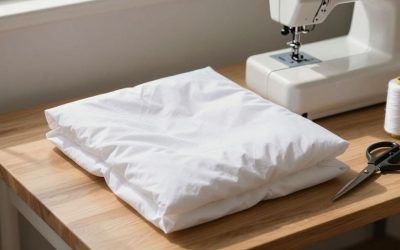When it comes to comfort and convenience, pillow choice is an important part of any good night’s sleep. Deciding between feather pillows and microfiber pillows can be a difficult decision. In this article, we will compare the two products in order to determine which is the better choice.
What Are Feather Pillows?
A feather pillow is a comfortable cushion made with a core of feathers surrounded by a shell. These feather cores, or “clusters,” can be made with various types of feathers, including duck and goose, as well as synthetic fibers. The heavier the feathers, the more expensive the pillow will be.
Feather pillows are known for their softness and cushioning, with some people favoring them for their luxurious feel. Feather pillows tend to be heavier than other types of pillows, and they also tend to be more expensive than other types of pillows. Feather pillows are available in various sizes and shapes, including square, oblong and U-shaped models.
Feather pillows are also known for their durability, as they can last for many years with proper care. They are also hypoallergenic, making them a great choice for people with allergies. Additionally, feather pillows are easy to clean and maintain, as they can be spot-cleaned with a mild detergent and warm water.
Feather pillows are a great choice for those looking for a comfortable and luxurious pillow. They are available in a variety of sizes and shapes, and they are also durable and hypoallergenic. With proper care, a feather pillow can last for many years, making it a great investment for a good night’s sleep.
What Are Microfiber Pillows?
Microfiber pillows are pillows that are filled with down alternative materials, such as polyester fibers, instead of feathers. This gives them a softer feel than feather pillows while still providing comfortable support. They are also typically less expensive than feather pillows. Microfiber pillows are lightweight and have a synthetic cover that is often smooth to the touch.
Microfiber pillows also come in a variety of sizes and shapes, including traditional square and U-shaped variants. They are often hypoallergenic and are considered to be a more affordable alternative to feather pillows.
Microfiber pillows are also easy to care for and maintain. They can be machine washed and dried, and they are usually resistant to dust mites and other allergens. Additionally, they are often more durable than feather pillows, making them a great choice for those who want a pillow that will last for years.
Microfiber pillows are a great choice for those who want a comfortable and supportive pillow without the expense of a feather pillow. They are lightweight, hypoallergenic, and easy to care for, making them a great option for anyone looking for a comfortable and affordable pillow.
Pros and Cons of Feather Pillows
Feather pillows offer some advantages over other types of pillows. They are known for providing superior comfort, cushioning and support. Highly weighted ducks and geese feathers provide optimal support for the neck and back, and are often preferred by those who experience neck pain or stiffness. Feather pillows are also longer lasting than other types of pillows, making them a better value.
On the downside, feather pillows tend to be a bit heavier and pricier than other pillow types. Some people may find them too warm due to their dense material makeup. Additionally, they may not be the ideal type of pillow for those who suffer from allergies due to the presence of feathers and other materials.
Feather pillows may also require more frequent fluffing and shaking to maintain their shape and loft. Additionally, they may require more frequent washing than other types of pillows, as the feathers can become matted and clumped over time.
Pros and Cons of Microfiber Pillows
Microfiber pillows offer some pros over other types of pillows. They are typically softer and lighter than feather pillows, making them easier to move around. They are also often more affordable than feather pillows. Additionally, many microfiber pillows are hypoallergenic, which is an important factor for those with allergies.
On the downside, some find microfiber pillows to be too lightweight and not supportive enough for neck or back pain relief. Additionally, they may not provide the same cushioning and comfort as feather pillows, which can lead to poor quality sleep if not carefully selected.
Microfiber pillows are also not as durable as feather pillows, and may need to be replaced more often. They may also be more prone to flattening over time, which can reduce their comfort level. Finally, some microfiber pillows may contain synthetic materials that can be irritating to sensitive skin.
When selecting a pillow, it is important to consider the pros and cons of microfiber pillows. While they may be more affordable and hypoallergenic, they may not provide the same level of comfort and support as feather pillows. Additionally, they may not be as durable or long-lasting. Ultimately, it is important to choose a pillow that best meets your individual needs.
Factors to Consider When Choosing Between Feather Pillows and Microfiber Pillows
It is important to consider your needs when choosing a pillow. Your pillow needs to fit your body’s needs in order to provide maximum comfort and support. There are several factors you need to consider when making this decision, such as comfort, price, durability and maintenance requirements.
Comfort should be your primary concern when selecting a pillow. If you have chronic neck pain or stiffness, choosing a feather pillow over a microfiber pillow may be the best option for you. On the other hand, if you just want a softer pillow for sleeping, you may prefer a microfiber pillow over a heavier feather pillow.
When it comes to price, feather pillows tend to be more expensive than microfiber pillows. However, feather pillows are more durable and require less maintenance than microfiber pillows. Feather pillows can last for years with proper care, while microfiber pillows may need to be replaced more often. Additionally, feather pillows are easier to clean and maintain than microfiber pillows.
Cost Comparison of Feather vs. Microfiber Pillow
Feather pillows typically come in at a slightly higher price point than microfiber pillows, but the cost difference varies greatly depending on the materials used and the weight of the pillow. Generally speaking, high-quality feather pillows can cost twice as much as an average microfiber pillow.
When comparing the two types of pillows, it is important to consider the quality of the materials used. Feather pillows are often made with higher quality materials than microfiber pillows, which can make them more expensive. Additionally, feather pillows tend to be heavier than microfiber pillows, which can also add to the cost. However, the extra cost may be worth it for those who prefer the comfort and support of a feather pillow.
Durability Comparison of Feather vs. Microfiber Pillow
Feather pillows can last much longer than microfiber pillows due to the dense materials used in their construction. Feather pillows can last up to three times longer than microfiber pillows when properly cared for.
Feather pillows are made from natural materials such as down, feathers, and wool, which are more durable than synthetic materials used in microfiber pillows. Feather pillows are also more resistant to wear and tear, and can withstand more frequent use than microfiber pillows.
In addition, feather pillows are more resistant to dust mites and allergens, making them a better choice for people with allergies. They are also more breathable than microfiber pillows, which can help keep you cool and comfortable while you sleep.
When it comes to durability, feather pillows are the clear winner. They are more durable, more resistant to wear and tear, and more breathable than microfiber pillows. With proper care, feather pillows can last up to three times longer than microfiber pillows, making them a great investment for your sleep comfort.
Comfort Comparison of Feather vs. Microfiber Pillow
The general consensus is that feather pillows provide superior comfort over microfiber pillows. This is because they are heavier and provide more support for the neck and spine. Microfiber pillows may be too lightweight for some people, leading to an inability to get comfortable during sleep.
Maintenance Requirements for Feather and Microfiber Pillows
Both feather and microfiber pillows require regular maintenance in order to last longer and remain hygienic. Feather pillows usually require fluffing and regular washing with a mild detergent in order to keep them in good condition. On the other hand, microfiber pillows often require spot washing with a mild detergent.
Conclusion: Which is the Better Choice?
The choice between feather and microfiber pillow is an individual decision based on personal preference and individual needs. Feather pillows provide superior comfort, support and durability; however, they can be heavier and more expensive than microfiber pillows. Microfiber pillows offer lightweight comfort and affordability; however, they may not provide enough support for those with chronic neck pain or stiffness.



